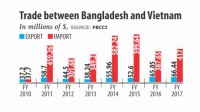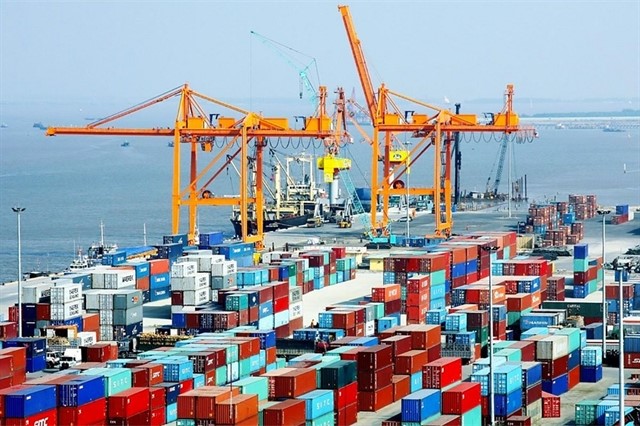-

Bangladesh targets $1b trade ties with Vietnam
-

VIETNAM COFFEE EXPORTS UNDER THE TOP 2 OF THE WORLD
-

Rice Exports by Country
-

Relations between Bangladesh and Vietnam
-

Bangladesh Economic Outlook 2019: A resilient economy in need of sound policy LIGHTCASTLE ANALYTICS WING
-

Bangladesh Economy Continues Robust Growth with Rising Exports and Remittances
-

Vietnam beats us in RMG for last 5 months in 2019
-

Bangladesh to seek more Vietnamese investment

Vietnam’s development over the past 30 years has been remarkable. Economic and political reforms under Đổi Mới, launched in 1986, have spurred rapid economic growth, transforming what was then one of the world’s poorest nations into a lower middle-income country. Between 2002 and 2018, GDP per capita increased by 2.7 times, reaching over US$2,700 in 2019, and more than 45 million people were lifted out of poverty. Poverty rates declined sharply from over 70 percent to below 6 percent (US$3.2/day PPP). The vast majority of Vietnam’s remaining poor – 86 percent – are ethnic minorities.
In 2019, Vietnam’s economy continued to show fundamental strength and resilience, supported by robust domestic demand and export-oriented manufacturing. Real GDP grew by an estimated 7 percent in 2019, similar to 2018, one of the fastest growth rates in the region.
Given its deep integration with the global economy, the Vietnamese economy has been hit hard by the ongoing COVID-19 pandemic, but has shown remarkable resilience. The initial health impact of the outbreak had not been as severe in Vietnam as in other countries due to proactive measures at the national and subnational levels. The macro-economic and fiscal framework remains resilient with an estimated GDP growth rate of 1.8 percent in the first half of 2020, projected to reach 2.8 percent for the year. Vietnam is one of the few countries in the world not to expect a recession, though its growth rate for this year is far less than the typical 6-7 percent pre-crisis projections. However, the impact of the ongoing COVID-19 crisis is hard to predict given the uncertainty surrounding its magnitude and duration. Public financing requirements will increase as the result of lower revenue and higher spending due to the stimulus package launched to mitigate the negative effect of the pandemics on households and businesses.
Thanks to its strong fundamentals, and assuming the relative control of the COVID-19 pandemic both in Vietnam and the world, the Vietnamese economy should rebound in 2021. COVID-19 has also shown the necessity for stronger reforms to help the economy recover in the medium term, such as improving business environment, promoting the digital economy, and enhancing public investment effectiveness and efficiency, which are some of the key agendas for Vietnam to consider stronger and faster reform actions.
Vietnam is experiencing rapid demographic and social change. Its population reached 96.2 million in 2019 (up from about 60 million in 1986) and is expected to expand to 120 million by 2050. According to the 2019 Population Census Report, 55.5 percent of the population is under 35 years of age, with a life expectancy of 76 years, the highest among countries in the region at similar income levels. But the population is rapidly aging. And Vietnam’s emerging middle class, currently accounting for 13 percent of the population, is expected to reach 26 percent by 2026.

Between 2010 and 2020, the Human Capital Index for Vietnam increases from 0.66 to 0.69. A Vietnamese child born today will be 69 percent as productive when she grows up as she could be if she enjoyed complete education and full health. Vietnam’s HCI is the highest among middle-income countries, but there are some disparities within the country, especially for ethnic minorities. There is also a need to upgrade the skills of the workforce to create productive jobs at a large scale in the future.
Health outcomes have improved in tandem with rising living standards. From 1993 to 2017, the infant mortality rate decreased from 32.6 to 16.7 (per 1,000 live births). Between 1990 and 2016, life expectancy increased from 70.5 to 76.3 years, and is the highest in the region for countries at a similar income level. Vietnam’s universal health coverage index is at 73—higher than regional and global averages—with 87 percent of the population covered. However, the high and widening sex ratio at birth (115 in 2018) shows that fundamental gender discrimination persists. At the same time, Vietnam is one of the most rapidly aging countries and the 65+ age group is expected to increase 2.5 times by 2050.
Over the past 30 years, the provision of basic services has improved significantly. Access of households to infrastructure services has increased dramatically. As of 2016, 99 percent of the population uses electricity as their main source of lighting, up from just 14 percent in 1993. Access to clean water in rural areas has also improved, up from 17 percent in 1993 to 70 percent in 2016, while that figure for urban areas is above 95 percent. However, in recent years, Vietnam’s physical capital investment as a percentage of GDP has been among the lowest in the ASEAN region. This will create challenges for continued growth of modern infrastructure services required for the next phase of growth (Vietnam ranks 89th out of 137 countries for quality of its infrastructure).
Vietnam’s rapid growth and industrialization have had detrimental impacts on the environment and natural assets. Electricity consumption has tripled over the past decade, growing faster than output. Given the increasing reliance of fossil fuels, the power sector itself accounts for nearly two-thirds of the country’s greenhouse gas emissions. There is an urgent need to accelerate the clean energy transition. Over the past two decades, Vietnam has emerged as the fastest growing per-capita greenhouse gas emitters in the world – growing at about 5 percent annually. Demand for water continues to increase, while water productivity is low, about 12 percent of global benchmarks. Unsustainable exploitation of natural assets such as sand, fisheries, and timber could negatively affect prospects for long-term growth. Compounding the problem is the reality that much of Vietnam’s population and economy is highly vulnerable to climate impacts.
Urbanization and strong economic and population growth are causing rapidly increasing waste management and pollution challenges. Waste generation in Vietnam is expected to double in less than 15 years. Linked to this is the issue of marine plastics. Ninety percent of global marine plastic pollution is estimated to come from just 10 in-land rivers, and the Mekong river is one of them. Vietnam is among the 10 countries worldwide that are most affected by air pollution. Water pollution has significant costs on productivity of key sectors and human health.
The government is working to lower the environmental footprint of the country’s growth and effectively mitigate and adapt to climate change. Key strategies and plans to stimulate green growth and sustainable use of its natural assets are in place. The government is also implementing measures to mitigate and adapt to climate change and address extreme weather events and natural disasters by operationalizing its Nationally Determined Contribution (NDC).
|
Main Indicators |
2018 |
2019 |
2020 (e) |
2021 (e) |
2022 (e) |
|---|---|---|---|---|---|
|
GDP (billions USD) |
304.02 |
329.54e |
340.60 |
369.49 |
404.91 |
|
GDP (Constant Prices, Annual % Change) |
7.1 |
7.0e |
1.6 |
6.7 |
7.4 |
|
GDP per Capita (USD) |
3 |
3e |
3 |
3 |
4 |
|
General Government Gross Debt (in % of GDP) |
43.6 |
43.4e |
46.6 |
47.1 |
47.2 |
|
Inflation Rate (%) |
3.5 |
2.8 |
3.8 |
4.0 |
4.0 |
|
Unemployment Rate (% of the Labour Force) |
2.2 |
2.2 |
3.3 |
2.7 |
2.4 |
|
Current Account (billions USD) |
5.77 |
11.26e |
3.96 |
6.19 |
3.59 |
|
Current Account (in % of GDP) |
1.9 |
3.4e |
1.2 |
1.7 |
0.9 |
Copyrights Thiet Ke Website by ungdungviet.vn





